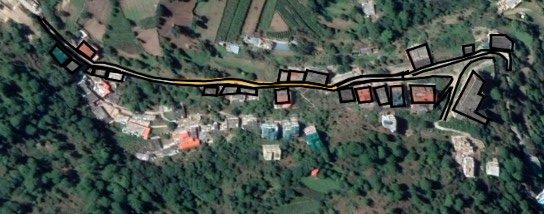CHANGING DYNAMICS OF VALUATION OF PROPERTIES IN THE HINTERLAND OF HILLY AREAS
AUTHOR: AR. RITA MINHAS
We all know very well that, in this Universe, change is the only constant. If we look around carefully, the growth of cities is not in linear mode but they are leapfrogging from medium size towns to large cities. Population growth and expansion of cities is inevitable and so is the expansion of cities.

According to World Bank data, in India, approximately 36% population resided in urban areas in 2019. The level of urbanization in the country as a whole increased from 25.7% in 1991 to 27.82% in 2001 and to 31.14% in 2011 Till recent times, what used to be evident in a decade’s time, is now happening in two to three years. There has been a magnificent digital revolution that has made everyone aware of the latest and the best. You name anything, consumables, electronics, automobiles, hospitality, etc, everyone is aware of these.

Expansion of road networks has pumped new oxygen into the lungs of barren, inaccessible lands of the hinterland, especially in hilly regions.
Speculators, the big fish, have captured the far flung beautiful serene lands, almost everywhere you go. In turn, the locals have also been benefitted from the various infrastructure facilities, these speculators sometimes help to create. And of course, it brings a sea of change in the land economics. Construction of one resort or a hotel, in an area changes the local scenario, attracting other people to invest further.
I am sometimes amazed when I visit some rural hilly locale, which otherwise appears untouched scenic haven, and I find out that all the land nearby has been sold out. Upon interaction with the local people, they are happy to tell that, land rates have increased many folds, even after one speculative deal. Yet, it is necessary to crack a balance between the preservation of local agriculture, culture, natural vegetation, and development. Hill Towns are seismically vulnerable, susceptible to heavy damage due to natural hazards like landslides, floods, cloudbursts,s and forest fires.

Environmentally these areas are sensitive and susceptible to changes in the microclimate, loss of vegetation cover increase in surface runoff, reduction in recharging of aquifers and water table, and increase in soil erosion and flooding. A guided development regime is a must, not only for the urban areas but also for the rural hinterland as 64% of the population resides in rural areas.
Effective development control rules are imperative to tackle the important issues such as overcrowding, congestion due to buildings, narrow streets having no further scope for widening, dearth of parking spaces, buildings devoid of proper light and ventilation.
Ribbon development, an important morphology of the urbanization process, along the transport routes, is yet another trend, that is prevalent everywhere. Ribbons tend to be visible and expand fastest near the settlements, whether urban or rural, laying founding stones of future agglomerations.

These zones become hot brimming areas for economic activities including commercial and mixed residential yielding higher valuations of properties. Apart from these areas near settlements, ribbons tend to mushroom all along the routes on slower roads further slowing the traffic. Thus, there needs to be a balance between how much and where. A pleasant driving experience, where views are not blocked and the feeling of being in the lap of nature is not eroded, could be achieved thus.
Hence, the Ru-urban integrated mode of development needs to be implemented in the regions with tourism potential. A climate-responsive approach, higher safety measures, visually conducive development, context-specific regulations, and better implementation strategies need to be given high priority.

Most often, we witness recurring instances of buildings collapse due to un-regulated site selection, un-engineered construction, weak implementation mechanism for regulations, buildings coming up irrespective of slope density relationship and climate responsive approach, insufficient setbacks leading to shady lower stories causing uncomfortable conditions, the demon of seepage and dampness in buildings due to in sufficient setbacks and scarcity of parking facilities.
Economic growth and development is everyone’s need. Yet there has to be a balance between environment, ecological conservation, and development.
A guided ribbon development with intermittent no-construction zones or regulated development for open valley views, for certain stretches, and aggregating facilities at certain points, could be an answer.

Tourism is another catalyst, that is helping to increase the demand of land in far-flung areas, where tourists come for attaining peace and solitude. The recent pandemic situation created by Covid 19, further increased the demand for solitary habitats, such as holiday homes, resorts or homestays well connected by road and internet networks. The Pandemic also lead to an increase in demand for apartments in hill stations.
Work from home culture gained popularity. This has eliminated the need to stay near work places. Now people are not yearning for accommodation near town centres. Apartment Projects are coming up in remote locations as well. These are all positive signs of economic vibrancy after tough times witnessed during Covid19.
Valuations would tend to be higher, if the organic growth pattern was regulated, thus preventing the haphazard growth, that we repent now, in most of our cities. Valuations are increasing in the hinterland, but this should not be at the cost of environmental imbalance and chaos.
ABOUT THE AUTHOR

AR. RITA MINHAS
Graduation in Architecture, AIIA
Master of City Planning IIT KHARAGPUR
Registered Valuer (Land & Building)
IBBI Registration Number: IBBI/RV/10/2021/13874
CORE COMPETENCE & INDUSTRY-SPECIFIC EXPERIENCE
Residential and commercial Architecture, Earthquake Safe Technology Implementation in construction, Master Planning, MIS, GIS Mapping, Neighbourhood Planning, Affordable housing, Estimation & Budgeting. She has 15 years of experience in Residential Architecture and the real estate industry which has provided her good understanding of a variety of projects. She has been handling Valuation Assignments for Land & Building for various Banks as well as companies under Company Act.

